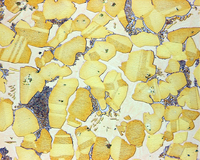
Photo from wikipedia
Abstract The numerical simulation of fracture phenomena occurring in real microstructures of heterogeneous materials is a particularly complicated problem, involving complex cracking processes. On the basis of recent investigations, it… Click to show full abstract
Abstract The numerical simulation of fracture phenomena occurring in real microstructures of heterogeneous materials is a particularly complicated problem, involving complex cracking processes. On the basis of recent investigations, it is obvious that the phase-field approach has a strong potential to model these processes. However, it requires fine spatial discretization to resolve the smooth transition of the diffusive crack representation regulated by a small length scale parameter. Thus, it tends to be computationally intensive when combined with an inefficient solution scheme. In this paper, recently developed staggered solution procedure based on the residual norm control has been employed for the fracture analysis of heterogeneous microstructure exhibiting crack initiation and complex crack paths. Four different sample sizes have been analyzed, chosen from the simplified geometry of a nodular cast iron microstructure where the size-effect has been observed. The detailed discussions regarding the accuracy and CPU time usage have been given. An improvement in computational efficiency is demonstrated in comparison to the common single iteration staggered algorithm.
Journal Title: Theoretical and Applied Fracture Mechanics
Year Published: 2019
Link to full text (if available)
Share on Social Media: Sign Up to like & get
recommendations!